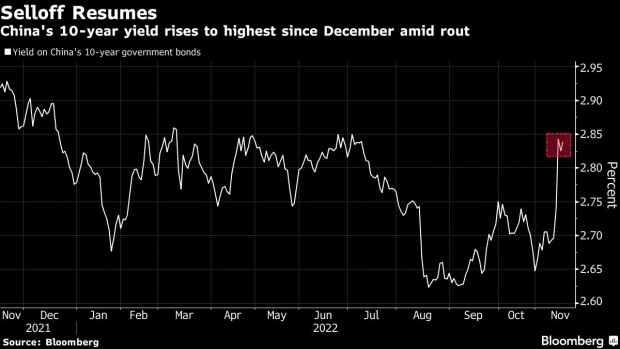Nov 16, 2022
China’s Bond Selloff Resumes With Yield Rising to One-Year High
, Bloomberg News

(Bloomberg) -- Things are finally looking up for China’s economy, and with that traders are ditching government bonds for riskier bets.
Yields on benchmark 10-year debt jumped as much as four basis points to 2.85% on Wednesday, the highest since December. This follows their biggest rout since late 2016 on Monday, with a rise in interbank rates adding to the drag on the market. Investors also sold corporate bonds.
A growing optimism about the world’s no. 2 economy is altering the narrative on Chinese assets, and forcing traders to recalibrate their bets on the nation’s stocks, bonds and currency. Almost overnight, sovereign debt has lost its appeal as expectations for aggressive easing wane, and Chinese equities rally amid bullish calls from the likes of Bank of America.
“China bonds may have priced in too much pessimism over economic growth and the steep climb in yields is reflecting a turnaround of sentiment,” said Ming Ming, chief economist at Citic Securities. “The easing bets on PBOC RRR cut or rate cut built previously have been harder to materialize, triggering the big retreat in bonds.”
There was heavy selling by mutual funds and banks’ wealth management units in the afternoon, which pushed yields higher across the curve, according to traders who asked not to be named as they are not authorized to speak publicly.
Rising interbank borrowing costs also reduced the profitability of traders’ leveraged wagers on debt, which may have contributed to the drop in bonds, said Tan Songheng, general manager of fixed income investment at Bank of Sanxiang.
The selloff in bonds, also reflected in the local credit scene, comes on the heels of a jump in US-listed Chinese stocks on Tuesday which put the shares on course for the biggest monthly gain on record. The Hang Seng Index climbed 25% from an October low to enter a bull market.
The shift in sentiment comes in the wake of moves by President Xi Jinping to ease some Covid curbs and roll out measures to shore up the ailing property sector. Signs of a thaw in tensions between Beijing and Washington also brightened the outlook for trade.
Xi’s Three Big Pivots Rescue China Markets From Downward Spiral
To be sure, the improving prospects for China’s economy may exert more upward pressure on money-market rates. The overnight repo rate, a gauge of borrowing costs among banks and a popular funding tool for leverage trades in bonds, rose to 1.95% on Wednesday, the highest since September.
Similarly, the rate on one-year interbank AAA certificates of deposit climbed to 2.6% on Wednesday, the highest since April. This brings it close to the central bank’s medium-term lending facility policy rate of 2.75%.
Liquidity conditions have tightened after corporates made tax payments in October and banks replenished their funding to boost lending heading into the year-end.
All this may mean that government bonds could post more losses.
Ten-year sovereign yields may climb to a range of 2.9% to 3% within the year, according to Citic’s Ming. Winson Phoon, head of fixed income research at Maybank Kim Eng Securities in Singapore, reckons they are likely to trade in the 2.75% to 2.95% zone pending more clarity from economic data.
--With assistance from Chester Yung.
(Updates throughout)
©2022 Bloomberg L.P.






